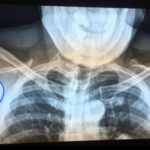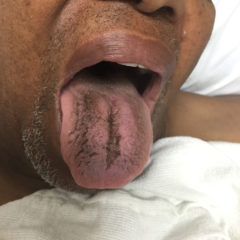Bilateral Shoulder Dislocation after Ski Injury
History of present illness:
The patient was a 60-year-old male who had been skiing when he abruptly fell with arms overhead (superman position). The patient immediately experienced bilateral shoulder pain and was rushed to the clinic associated with the ski resort. On physical exam, he had bilateral step-off deformities and both shoulders were abducted approximately 15 degrees with elbows flexed at 90 degrees. He promptly received X-rays which demonstrated bilateral anterior shoulder dislocation and left humeral head fracture.
Significant findings:
An anteroposterior chest X-ray demonstrates bilateral shoulder dislocations. Both the right and left humeral heads (blue lines) are displaced medially, anteriorly, and inferiorly from their normal positions in the glenoid fossae (red lines), thus signifying bilateral anterior dislocations. There is also a fracture of the left humeral head at the greater tubercle (green arrow).
Discussion:
While anterior shoulder dislocations are the most common major joint dislocation seen in emergency departments, bilateral anterior shoulder dislocation is exceedingly rare.1,2 There are few other cases of bilateral shoulder dislocation reported in the literature. Most are posterior dislocations related to seizure, electrocution, or trauma, with fewer than 50 cases since 1966.1,3,4,5 The first report was in 1902.1 The mechanism is fairly specific for anterior dislocation with multiple publications reporting the patient falling onto bilateral outstretched hands. Another less common mechanism is trauma sustained with arms in the “pushup position.”2
Initial presentation of bilateral anterior shoulder dislocation is usually obvious on physical exam. A patient’s shoulders may be externally rotated and abducted. Patients may also exhibit bilateral squaring of the shoulders with flattened lateral deltoid known as the epaulet sign (named for the French term for shoulder ornaments of military uniforms).2,6 Treatment is the same for unilateral dislocation, and requires immediate reduction with subsequent evaluation for any neurovascular compromise. Though 20% of bilateral dislocation cases present with neurologic symptoms, 75% of these resolve after reduction.2 After reduction the patient’s affected arms should be immobilized via slings. The most commonly chosen position is to keep the shoulders adducted and internally rotated. Younger patients can remain in the slings for three weeks; however, patients over the age of 30 should begin early mobilization after one week to prevent adhesive capsulitis.7 The patient should follow up for orthopedic evaluation and physical therapy for range of motion exercises.8 About 23% of patients with this rare bilateral deformity will require some form of follow-up surgery.2
In this case, the left-sided reduction was completed easily by forward flexion of the arm with acromion pressure and medial rotation of the scapula without analgesia. The right shoulder required administration of analgesia and two reduction attempts with successful reduction using external rotation and abduction. Repeat X-rays were obtained showing adequate reduction. The patient was neurovascularly intact before and after reduction. The patient was immobilized in slings and orthopedic follow up with physical therapy was prescribed.
Topics:
Shoulder dislocation, bilateral, ski injury.
References:
- Meena S, Saini P, Singh V, Kumar R, V Trikha. Bilateral anterior shoulder dislocation. J Nat Sci Biol Med. 2013:4(2):499-501. doi: 10.4103/0976-9668.117003
- Ballesteros R, Benavente P, Bonsfills N, Chacon M, Garcia-Lazaro FJ. Bilateral anterior dislocation of the shoulder: review of seventy cases and proposal of a new etiological-mechanical classification. J Emerg Med. 2013;44(1):269-279. doi:10.1016/j.jemermed.2012.07.047
- Page AE, Meinhard BP, Schulz E, Toledano B. Bilateral posterior fracture-dislocation of the shoulders: management by bilateral shoulder hemiarthroplasties. J Orthop Trauma. 1995;9(6):526-529.
- Dinopoulos HT, Giannoudis PV, Smith RM, Matthews SJ. Bilateral anterior shoulder fracture-dislocation. A case report and a review of the literature. Int Orthop. 1999;23(2):128-130.
- Dunlop CC. Bilateral anterior shoulder dislocation–a case report and review of the literature. Acta Orthop Belg. 2002;68(2):168-170.
- “Epaulet.”Merriam-Webster.com. https://www.merriam-webster.com/dictionary/epaulet. Accessed 26 March 2018.
- Smith TO. Immobilisation following traumatic anterior glenohumeral joint dislocation: a literature review. Injury. 2006;37(3):228-237. doi:10.1016/j.injury.2005.06.005
- Aronen JG, Regan K. Decreasing the incidence of recurrence of first time anterior shoulder dislocations with rehabilitation. Am J Sports Med. 1984;12(4):283-291. doi:10.1177/036354658401200408




